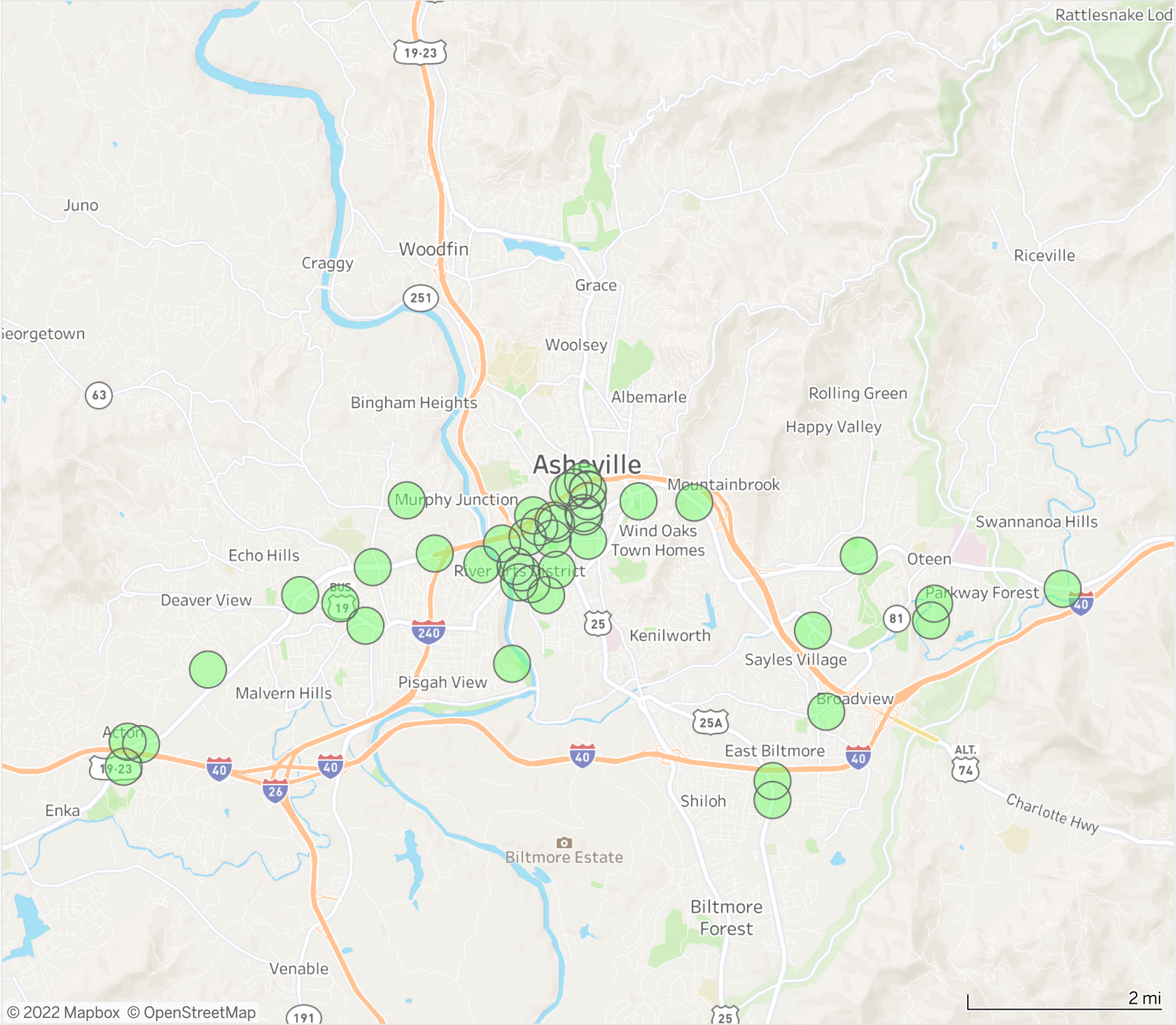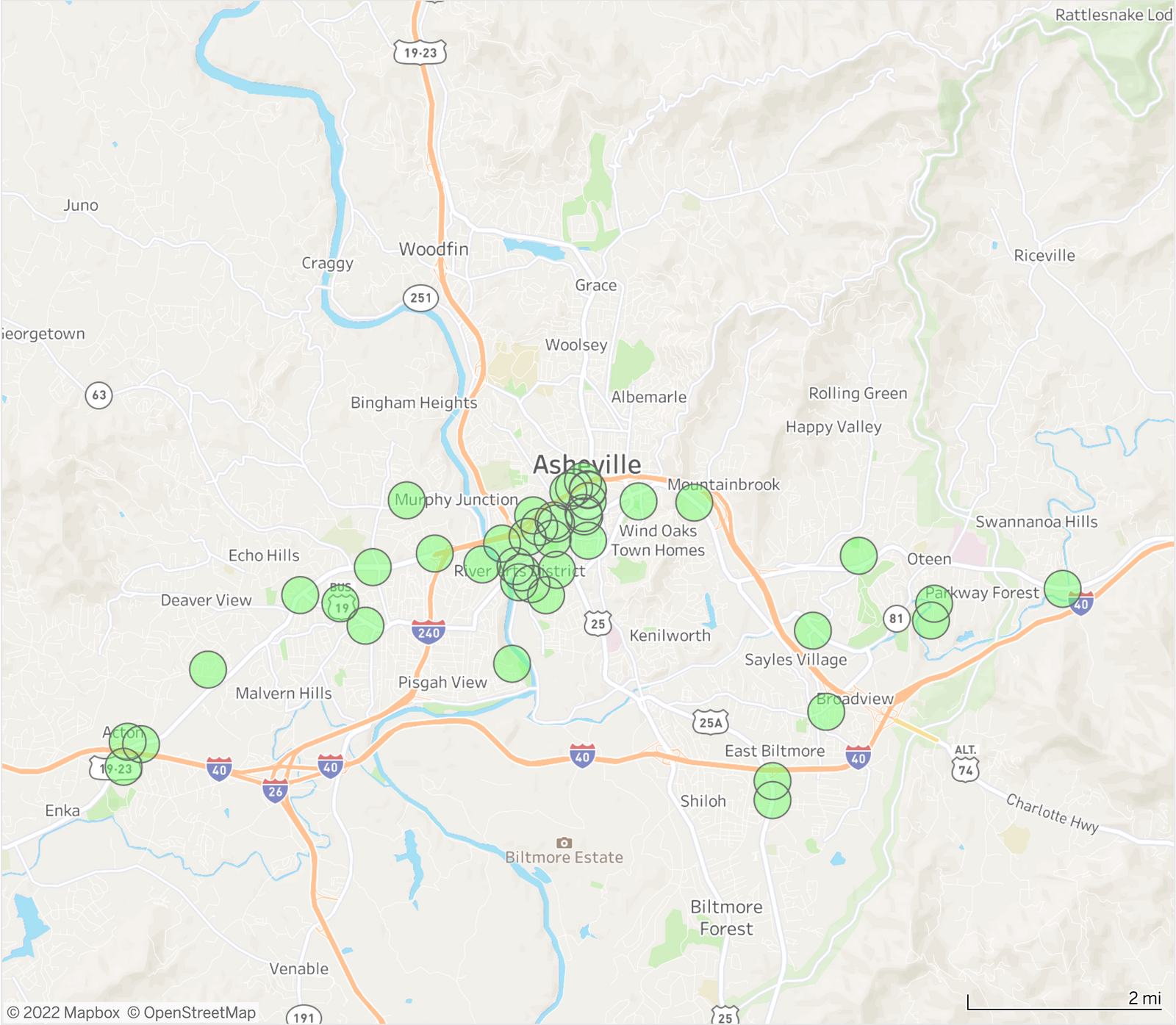On January 11, 2022, during the first City Council meeting of the year, Asheville Police Department (APD) Captain Mike Lamb presented the department’s justification for unofficially changing its policy on encounters with unhoused individuals. The new official policy, which was signed into effect over a month later on February 15, 2022, shortened the amount of eviction notice time APD would give to unhoused urban campers from 7 days to a mere 24 hours or less.
The cornerstone of Lamb’s presentation was a slide entitled “Large Encampment Crime Issues,” which purportedly demonstrated that these encampments were responsible for as much as 22% of all crime that occurred in the city in 2 years. Despite a lack of transparency from APD on how exactly they assembled this information, analysis of the claims made in the slide and the underlying data we were able to obtain reveals an alarming lack of rigor.
Nearly All of Downtown and RAD Fall Within APD's Area.
On the night of the presentation, The Asheville Free Press requested APD release data that substantiated the “Large Encampment Crime Issues” slide. The public records department provided us with two tables showing a list of addresses, crime counts for each, and a note explaining that the date range was from January 1, 2020, to January 9, 2022. The crime counts were unusable as they didn’t add up to the totals listed on the slide (more on this below).
There are 43 addresses listed in the documents. Despite claiming they were counting crimes near “large encampments,” cross-checking this list against a “Homeless Camp Issues and Responses” document reveals that several of these addresses were only home to a single person, or small group of people, for a short period of time—most are completely unaccounted for. Additionally, since APD is not controlling for the dates during which camps existed, a small camp that existed for a matter of weeks casts a 1,000-foot radius over the entire 2-year period.
Plotting these addresses and drawing a 1,000-foot radius around them reveals that APD blames nearly all crime in Downtown Asheville and the River Arts District over a 2-year people on unhoused urban campers.
Note: A 1,000-foot radius results in a 2,000-foot diameter.

This is a significant portion of the city. Even assuming the counts are 100% accurate, there is still no evidence provided to suggest that these crimes involved unhoused individuals at all.
Correlation Does Not Equal Causation.
An independent analysis by data analyst Nicholas Pierson, provided to The Asheville Free Press upon request, came to similar conclusions as those above. Pierson, however, took the research a step further.
As detailed in a presentation prepared for the City Council meeting on February 22, 2022, Pierson further demonstrates issues with the correlation between crime hotspots and camps. Pierson uses publicly available arrest data to demonstrate that you can produce similar results using completely unrelated hotspots such as bars or hotels.
“Geotagging police arrest addresses & measuring distance shows 14.7% of arrests only [...] within 500 feet and 27.1% of arrests within 1000 feet. However, a set of unrelated hotspots [...] yields almost identical results: 14.1% of arrests within 500 feet and 26.2% within 1000 feet” of bars and hotels, Pierson says in his presentation.
“Almost every police site labeled as a ‘homeless encampment’ corresponds to a populated area or business district [...] Crime occurs where people live, work, and spend time in general, not just where there are unhoused people living.”
Should Unverifiable Data Drive Policy?
The public records released to us do not substantiate APD's claims due to significant inconsistencies.
Justin Feldman, a social epidemiologist and Health and Human Rights fellow at Harvard University, pointed out several of these inconsistencies in an email to us.
“The numbers are not consistent in some obvious ways. If we look at the 1000 ft radius, the slide reports 301 violent crime incidents vs. 667 in the table (adding up the 4 categories’ ‘grand totals’ for violent crimes). The slide also includes overdoses (not a crime in itself, obviously!), but the tables do not. Also on the slide: property crimes + violent crimes is less than total crimes. So they’re including other incidents... not clear which ones,” Feldman said. “In short, this isn’t adding up.”
In his analysis, Pierson came to a similar conclusion. “This is just wrong,” he said of the tables provided via public records in a call with us. “You can’t total crimes up like this.” Pierson made a point of showing the dangers of duplicate counting in his presentation using publicly available arrest data. By improperly counting arrests that occurred within the 1,000-foot radius of multiple “encampment” locations, he demonstrated a 107% overcount.
On January 14, after receiving the incorrect tables, The Asheville Free Press followed up with the City and asked for concrete information to aid in our analysis. Here is what we requested:
- In general, what was the methodology used to make these calculations?
- What was the original data source and determinants used to define the list of camps? I.e. was it camps where a certain number of people lived for a certain amount of time? How many people and how much time, Etc? In other words, why are these camps on this list?
- Are there any records showing when camps were active vs when they were not active?
- What was the original data source used to count crimes?
- Please provide any and all of the following: the files, calculation, map, process, query, code, hand-drawn notes, and/or GIS files used to identify which crimes occurred at specific proximities to which camps. If the data sources were composed of several files or data tables joined together or a query given to data tables, please provide those data tables and the code or query used to join them.
APD responded to these requests by saying that Captain Mike Lamb identified the camps based on the “Homeless Camp Issues and Responses” document mentioned above and “Captain Lamb’s knowledge of active encampments over the last two years.” They continued, “regarding the methodology, the data source used to count crimes is the City’s internal crime data, which aligns with the public crime data available on the Open Data Portal.”
The crime counts provided do not, in fact, align with the public crime data available on the Open Data Portal. The other specific requests were ignored, as were subsequent attempts at further clarification.
Fact-Check The Police.
Given these inconsistencies and lack of cooperation from APD on rectifying them, it would be irresponsible journalism to analyze beyond what we’ve stated above. Equally irresponsible is journalism that takes these statistics at face value without verification. The lack of rigor in APD's analysis was befitting of a propaganda campaign, not serious data science or a genuine concern for the health and safety of the most vulnerable people in our community.
Council Member Sage Turner said these statistics were “shocking” during Captain Lamb’s presentation. Indeed, that seems to have been the point. The Asheville Free Press has demonstrated before that Asheville Police will twist facts to suit their narratives—especially on highly politicized issues like protesting police injustice and homelessness.
Failure to fact-check the police is media malpractice.
Words by Ursula Wren. Data visualizations and analysis by Elliot Patterson.





